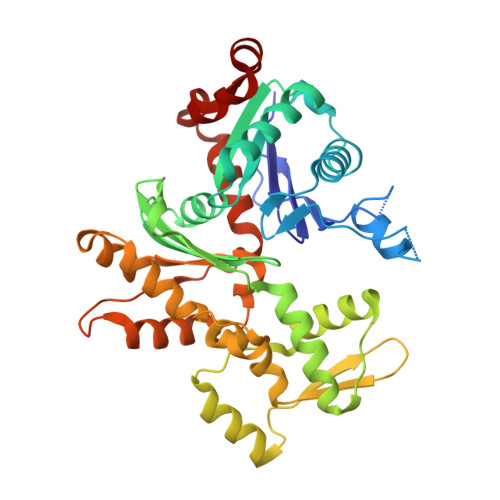Structural evidence for the roles of divalent cations in actin polymerization and activation of ATP hydrolysis
Scipion, C.P.M., Ghoshdastider, U., Ferrer, F.J., Yuen, T.Y., Wongsantichon, J., Robinson, R.C.(2018) Proc Natl Acad Sci U S A 115: 10345-10350
- PubMed: 30254171
- DOI: https://doi.org/10.1073/pnas.1806394115
- Primary Citation of Related Structures:
5YPU - PubMed Abstract:
The structure of the actin filament is known at a resolution that has allowed the architecture of protein components to be unambiguously assigned. However, fully understanding the chemistry of the system requires higher resolution to identify the ions and water molecules involved in polymerization and ATP hydrolysis. Here, we find experimental evidence for the association of cations with the surfaces of G-actin in a 2.0-Å resolution X-ray structure of actin bound to a Cordon-Bleu WH2 motif and in previously determined high-resolution X-ray structures. Three of four reoccurring divalent cation sites were stable during molecular dynamics (MD) simulations of the filament, suggesting that these sites may play a functional role in stabilizing the filament. We modeled the water coordination at the ATP-bound Mg 2+ , which also proved to be stable during the MD simulations. Using this model of the filament with a hydrated ATP-bound Mg 2+ , we compared the cumulative probability of an activated hydrolytic water molecule approaching the γ-phosphorous of ATP, in comparison with G-actin, in the MD simulations. The cumulative probability increased in F-actin in line with the activation of actin's ATPase activity on polymerization. However, inclusion of the cations in the filament lowered cumulative probability, suggesting the rate of hydrolysis may be linked to filament flexibility. Together, these data extend the possible roles of Mg 2+ in polymerization and the mechanism of polymerization-induced activation of actin's ATPase activity.
Organizational Affiliation:
Institute of Molecular and Cell Biology, Agency for Science, Technology, and Research (A*STAR), Biopolis, 138673 Singapore.


















